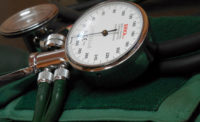Emergency treatment for heart attack improving
But study says delays still occur

 Despite improvements in treating heart attack patients needing emergency artery-opening procedures, delays still occur, particularly in transferring patients to hospitals that can perform the procedure, according to a study in Circulation: Journal of the American Heart Association.
Despite improvements in treating heart attack patients needing emergency artery-opening procedures, delays still occur, particularly in transferring patients to hospitals that can perform the procedure, according to a study in Circulation: Journal of the American Heart Association.
Fast response is critical for ST-segment elevation myocardial infarction (STEMI) patients. This severe heart attack is caused by a complete blockage of blood supply to the heart. More than 250,000 people suffer a STEMI each year.
But not all hospitals are equipped to perform artery-opening angioplasty – only about 25 percent in the United States. Facilities that can’t perform the procedure, also known as percutaneous coronary intervention, or PCI, typically refer and transfer patients to others that can.
“While we are making tremendous progress in PCI hospitals, delays are still occurring during the transfer process,” said Timothy D. Henry, M.D., the study’s senior author and director of research at the Minneapolis Heart Institute Foundation at Abbott Northwestern Hospital in Minneapolis. “This is the first study that examines and identifies the specific reasons for delay of transfer patients.”
Researchers examined data from 2,034 STEMI patients transferred from 31 local non-PCI hospitals in Minnesota and Wisconsin to the Minneapolis Heart Institute from March 2003 to December 2009. Referring hospitals were up to 210 miles away from the Institute.
Despite long-distance transfers, 65.7 percent of patients were treated within120 minutes from the time of presentation at the initial referring hospitals.
However, 34.2 percent of patients experienced a delay in total treatment time, and the study found delays most frequently occurred at the referral hospital (64 percent), followed by the PCI center (15.7 percent) and during transport (12.6 percent).
Specifically, the 64 percent of delays at the referral hospital were caused by:
• awaiting transportation - 26 percent;
• emergency department delays - 14 percent;
• diagnostic dilemma - 9 percent;
• initial negative test for heart attack - 9 percent; and
• cardiac arrest - 6 percent.
Delays related to cardiac arrest were the most likely to result in death, with an in-hospital mortality rate of 31 percent. In contrast, some delays, like an initially negative heart attack test, had no increased risk of death.
“All delays are not created equally,” Henry said. “By identifying where the delays are we can improve the systems for transferring patients to get them the care they need.”
He said it’s important to recognize that the higher risk patients are faring the worst, so the less successful outcomes may be related to their advanced disease states.
In 2007, the American Heart Association launched Mission: Lifeline to help improve systems of care for STEMI patients by reducing barriers from the time 9-1-1 is called until hospital discharge. That includes lack of timely access to a hospital capable of performing angioplasty, 24 hours a day, seven days a week.
The American Heart Association also offers Mission: Lifeline Accreditation by the Society for Chest Pain Centers for hospitals meeting specific criteria as either a STEMI-receiving hospital or a STEMI-referral hospital.
“A study recently published in Circulation ‘Improvements in Door-to-Balloon Time in the United States, 2005 to 2010’ found that more than twice as many people are getting treatment within 90 minutes of arriving at an angioplasty hospital than were five years ago, so we are making great progress,” said Chris Granger, M.D., chairman of the Mission: Lifeline steering committee and professor of medicine and director of the Cardiac Care Unit at Duke University Medical Center in Durham, N.C. “But Dr. Henry’s study shows us that many patients still have delays, and that certain types of delays are associated with worse outcomes. So there is an important opportunity to further improve care, especially for patients being transferred from hospitals not equipped to do angioplasty.”
“Our ultimate goal is to improve timely access to angioplasty in patients with STEMI,” Henry said. “We’ve been very successful doing this in hospitals that are equipped to provide the procedure. This study emphasizes that now our focus should be on regional systems which seek to incorporate those hospitals that require patient transfer in the process.”
Co-authors are Michael D. Miedema M.D.; Marc C. Newell M.D.; Sue Duval, Ph.D.; Ross F. Garberich, M.S.; Chauncy B. Handran B.S.; David M. Larson M.D.; Steven Mulder, M.D.; Yale L. Wang, M.D.; and Daniel L. Lips, M.D.
Looking for a reprint of this article?
From high-res PDFs to custom plaques, order your copy today!






